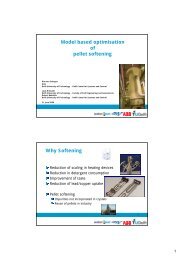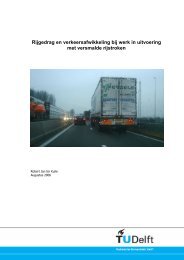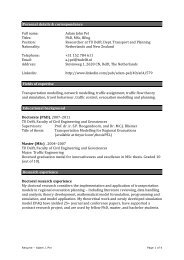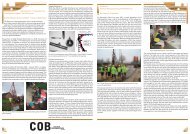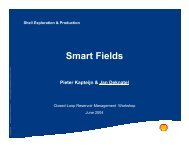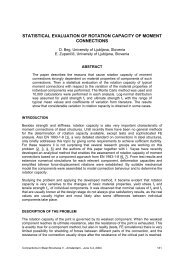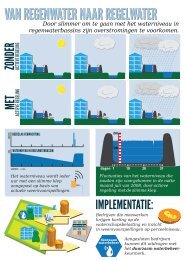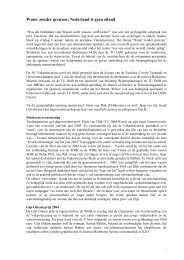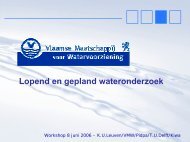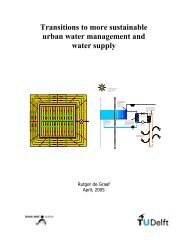Research on pedestrian traffic flow in the Netherlands - TU Delft
Research on pedestrian traffic flow in the Netherlands - TU Delft
Research on pedestrian traffic flow in the Netherlands - TU Delft
Create successful ePaper yourself
Turn your PDF publications into a flip-book with our unique Google optimized e-Paper software.
Daamen, W, & Hoogendoorn, SP (2003). <str<strong>on</strong>g>Research</str<strong>on</strong>g> <strong>on</strong> <strong>pedestrian</strong> <strong>traffic</strong> <strong>flow</strong>s <strong>in</strong> <strong>the</strong> Ne<strong>the</strong>rlands. In<br />
Proceed<strong>in</strong>gs Walk 21 IV (pp. 101-117). Portland, Oreg<strong>on</strong>, United States: Walk 21 c<strong>on</strong>ference.<br />
• Walk<strong>in</strong>g behavior<br />
o General applicable under various circumstances<br />
o Specifically for transfer stati<strong>on</strong>s<br />
• Route choice<br />
• Board<strong>in</strong>g and alight<strong>in</strong>g, or <strong>the</strong> <strong>in</strong>teracti<strong>on</strong> between public transport vehicles and<br />
walk<strong>in</strong>g as an access or egress mode<br />
• Activity behavior<br />
o Decisi<strong>on</strong> mak<strong>in</strong>g (activity choice, locati<strong>on</strong> choice)<br />
o Wait<strong>in</strong>g<br />
o Be<strong>in</strong>g served<br />
Most of <strong>the</strong> <strong>the</strong>oretical research is based <strong>on</strong> observati<strong>on</strong>s and functi<strong>on</strong> as basis for <strong>the</strong><br />
development of simulati<strong>on</strong> models. Some of <strong>the</strong>se general <strong>in</strong>novative approaches are not<br />
restricted to <strong>pedestrian</strong> <strong>flow</strong>s, especially experimental design issues, observati<strong>on</strong> techniques<br />
and model<strong>in</strong>g approaches.<br />
Simulati<strong>on</strong> models<br />
Two simulati<strong>on</strong> models have been developed: NOMAD and SimPed. NOMAD models<br />
<strong>in</strong>dividual <strong>pedestrian</strong>s. NOMAD c<strong>on</strong>sists of two mutually dependent models. The top-level<br />
model jo<strong>in</strong>tly predicts <strong>pedestrian</strong> activity schedul<strong>in</strong>g, activity area choice, and route choice <strong>in</strong><br />
public spaces. A ma<strong>in</strong> <strong>in</strong>novati<strong>on</strong> is that routes may be c<strong>on</strong>t<strong>in</strong>uous curves <strong>in</strong> space and time,<br />
ra<strong>the</strong>r than an ordered set of l<strong>in</strong>ks. Moreover, <strong>pedestrian</strong>s can choose between multiple<br />
activity areas where to perform <strong>the</strong>ir activities. The preferred locati<strong>on</strong> will be <strong>in</strong>fluenced by<br />
<strong>the</strong> route choice, and vice versa. The down-level model describes <strong>the</strong> walk<strong>in</strong>g behavior. The<br />
microscopic model is based <strong>on</strong> <strong>the</strong> behavioral assumpti<strong>on</strong> that optimal predictive feedback<br />
c<strong>on</strong>trollers with limited predicti<strong>on</strong> horiz<strong>on</strong> can describe <strong>pedestrian</strong>s adequately.<br />
SimPed is a simulati<strong>on</strong> model for <strong>pedestrian</strong> <strong>flow</strong>s, developed <strong>in</strong> co-operati<strong>on</strong> with Holland<br />
Railc<strong>on</strong>sult, a Dutch c<strong>on</strong>sult<strong>in</strong>g eng<strong>in</strong>eer<strong>in</strong>g firm for public transport and railway<br />
<strong>in</strong>frastructure. The aim of SimPed is to estimate both mean and variability of walk<strong>in</strong>g times<br />
<strong>in</strong>curred by transferr<strong>in</strong>g passengers and to visualize walk<strong>in</strong>g patterns <strong>in</strong>side transfer stati<strong>on</strong>s<br />
and o<strong>the</strong>r <strong>pedestrian</strong> areas. Simulati<strong>on</strong> studies with this tool quantify <strong>the</strong> effects of stati<strong>on</strong><br />
layouts <strong>on</strong> <strong>pedestrian</strong>s <strong>in</strong> a transfer stati<strong>on</strong>. Moreover, SimPed is used to analyze effects of<br />
timetables of <strong>the</strong> various public transport systems (departure and arrival times, type of roll<strong>in</strong>g<br />
stock) <strong>on</strong> passenger <strong>flow</strong>s <strong>in</strong> and through <strong>the</strong> transfer stati<strong>on</strong> (c<strong>on</strong>gesti<strong>on</strong>, transfer times).<br />
Board<strong>in</strong>g and alight<strong>in</strong>g <strong>in</strong> railway stati<strong>on</strong>s<br />
The durati<strong>on</strong> of dwell times at stati<strong>on</strong>s is determ<strong>in</strong>ed by <strong>the</strong> scheduled dwell times, <strong>the</strong><br />
number of alight<strong>in</strong>g and board<strong>in</strong>g passengers, tra<strong>in</strong> and <strong>in</strong>frastructural characteristics, and <strong>the</strong><br />
arrival and departure process of <strong>the</strong> tra<strong>in</strong>s (Wiggenraad (2002)).<br />
Parameters determ<strong>in</strong>ed are <strong>the</strong> dwell time and its comp<strong>on</strong>ents (board<strong>in</strong>g, alight<strong>in</strong>g, wait<strong>in</strong>g,<br />
etc.), <strong>the</strong> distributi<strong>on</strong> of <strong>the</strong> passengers over <strong>the</strong> platform, and <strong>the</strong> <strong>in</strong>fluence of type of stati<strong>on</strong>,<br />
<strong>the</strong> type of tra<strong>in</strong> service, vehicle characteristics (door passageway width) and period of day<br />
(peak and off-peak).<br />
105



